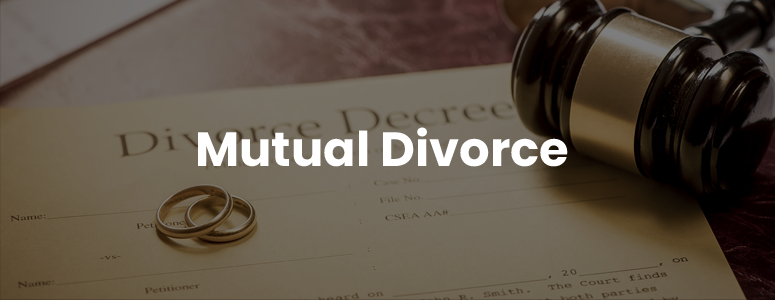5 Steps to follow in Divorce with Mutual Consent

The procedure of divorce or separation with mutual consent in India is less traumatic and less expensive as compared to the contested divorce method.
The lawful and legal method of separation after marriage, when both individuals (wife and husband) separate of their own free will after marriage, is called Divorce With Mutual Consent. Both the wife and husband can apply for the divorce mutually.
Divorce is called a divorce without mutual consent or a contested divorce when it is filed without the permission of either spouse(husband or wife). Most of the time, the idea and purpose for filing such divorce can be adultery, cruelty, conversion, desertion, communicable illness, the presumption of death, or mental disorder, in case of renouncing the world.
Steps to follow in Divorce with Mutual Consent
Step 1: Request or petition to file for divorce
Firstly, a joint petition for the discharge of marriage for a judgment of divorce is to be done to the family court by both the spouses on the spot, declaring that they are not prepared to live together and have mutually accepted to end their marriage or they have been living separately for one year or more.
This petition or appeal will, then, be approved by both the parties.
Step 2: Appearing before court and investigation of the petition
Both the individuals will have to be present in front of the family court after the filing of the petition. They both would present their respective attorneys/lawyers.
The court would critically examine the request along with all the reports and documents presented in the court. The court may even try to bring reconciliation among the spouses, though, if this is not reasonable, the matter returns for further follow ups.
After the appeal or petition is examined by the court to its satisfaction, it may require the parties’ records and statements to be recorded on oath.
Step 3: First motion is filed and a wait of 6 months is instituted before the second motion
Once the statements are filed and recorded, an order on the first motion is given by the court. Further, after this, six months are provided to both the individuals to divorce, before they can register the second motion.
The maximum time to arrange for a second motion is 18 months from the call for presentation of the divorce request petition in the family court.
Step 4: Final hearing of petition and the second motion
Once the individuals have chosen to go forward with the action and appear for the second motion, they can continue to final hearings.
This involves parties arriving and reporting and recording of statements in front of the Family Court.
Recently, the Supreme Court has maintained that the 6 months provided to the parties can be ignored at the discretion of the court.
Hence, for parties who have truly lived their differences including custody of the child, alimony, or any other unfinished issues between the parties, this six months can be waived.
Even if the court concludes that the waiting period will just extend their distress, the six months can be suspended off in this situation also.
Step 5: Decree of divorce
In a Mutual Divorce, both the individuals must have furnished consent and there shall not be any exceptions left in the matter associated with allegations regarding alimony, maintenance, custody of a child, property, etc. Therefore, there needs to be a perfect agreement between the spouses for the closing decision at the end of a marriage.
If the court is convinced after hearing the individuals that the charges in the petition are accurate and that there cannot be any chance of cohabitation and reconciliation, it can pass a decree of divorce stating the marriage to be dissolved. The Mutual Divorce Procedure becomes conclusive once the declaration of divorce has been announced by the court.
Most Crucial Points to Remember During the Divorce
- Child custody – which spouse will get custody of the child after the divorce
- Alumni/maintenance – if one of the spouses is not able to meet their daily expenses, then the other is required to pay them a certain sum. It is subject to mutual agreement between the spouses (husband and wife).
- Settlement of assets and property – settling the ownership benefits of investments and assets between the husband and wife
Documents Required for Divorce with Mutual Consent
Basic documents are required for registering a divorce petition. Further, Michael tell and Vakilsearch’s experts can help you get together the documents if anything is missing
- Marriage certificate
- Four photos of marriage.
- Address proof – husband and wife.
- Details of profession and income (appointment letter, salary slips)
- Income tax statement for the last 3 years
- Information about family (husband and wife)
- Details of property and asset owned
- Evidence relating to the failed attempts of reconciliation
- Evidence of staying separately for a year



